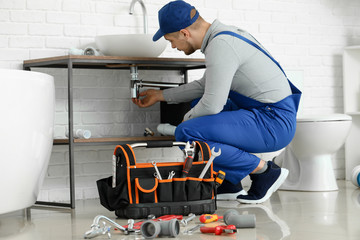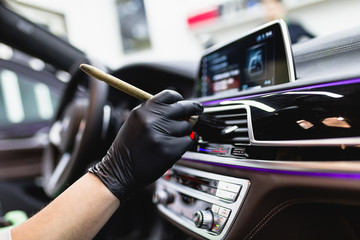HVAC systems warm or cool spaces and improve indoor air quality. They are essential in diverse settings like homes, offices, hospitals, and educational institutions.

Uneven temperature distribution within a building may occur due to blocked vents, improperly adjusted dampers, or dirty filters. Routine maintenance, such as cleaning vents and replacing air filters, helps ensure optimal airflow to alleviate these issues. Contact Ausco Air Heating & Air Conditioning for professional help.
The heating component of an HVAC system is responsible for bringing warm air into your home or office. It works by drawing in outside air through an intake vent and then transferring heat from the refrigerant to the air. Once the temperature is at a comfortable level, it will disperse the heated air throughout your property through ducts. Depending on the type of heating you have, the heat can be delivered at different speeds. The airflow can also be controlled with dampers, which help to regulate the flow and heat transfer.
There are several different types of heating systems, and they can be combined with air conditioning or ventilation systems to create a single unit. The most common is a split system, which consists of an indoor unit that houses the evaporator coil and blower and an outdoor unit that contains the compressor and condenser coil. Other systems use a packaged system, which integrates both heating and cooling into one unit that can be installed on the roof or near the base of the building.
In the past, most heating systems used gas to generate heat, but modern HVAC systems tend to use electricity to do this. This includes a variety of hybrid dual fuel systems that combine gas furnaces with electric air conditioning units.
Regardless of what type of heating you have, there are certain features that all HVAC systems have in common. The first is the heat exchanger, which transfers the fuel and air to produce heat. The heat exchanger usually has a metal or copper surface, and it is designed to have a high thermal conductivity. This allows it to transfer heat quickly and efficiently.
The next component of a heating system is the combustion system, which uses fuel to create fire that will warm the air. The combustion system is attached to the heat exchanger, and it can be gas or oil-based. Once the fuel has been burned, the heat is transferred to the air through the heat exchanger and then blown through the ductwork by the blower.
Other systems can use a heat pump to provide both heating and air conditioning. This is a boxy unit that can be found on the roof or in an attic, and it works by moving heat out of a house and into the environment. This is a more efficient method of warming a house than burning fuel, but it can be expensive to maintain and repair (Carrier).
Cooling
During the summer, your HVAC system is responsible for cooling your home. The way it works is by removing heat from your home through conduction, radiation and condensation. The heat is extracted from your home and expulsed outdoors, which cools the air in your home. The cooled air is then circulated throughout your house by ductwork.
The system also has a filtration component that is designed to remove particulates from the air. It is important that the filtration component has a high MERV rating. This is an industry standard for measuring the effectiveness of a filter. You should always check the MERV rating of any air filters that you are considering for purchase.
Another key function of HVAC systems is the way they control humidity. They do this by adjusting the temperature and moisture content of the air. This helps to prevent mold, mildew and other allergens from growing in your home.
You can get a HVAC system that is either ductless or ducted. A ducted system has a blower, air handler and ductwork. Ductless systems, on the other hand, are much smaller and don’t require any ductwork. They are able to provide the same level of comfort as a traditional system, although they are typically more expensive.
HVAC systems are vital to both residential structures like single-family homes and apartments buildings, as well as commercial and industrial buildings such as office buildings, factories, warehouses, hospitals and skyscrapers. Commercial HVAC systems are generally larger than residential units due to the greater size of the spaces they serve.
There are several factors that go into determining what kind of HVAC system you need in your home or business. A qualified HVAC professional can help you determine what your needs are and what system would be best suited for your space. They can also help you understand the energy efficiency of different systems.
Most new HVAC systems have energy-saving features that will help you save money on your utility bills. These features can include variable speed fans, smart thermostats and other advanced technology. They will also help you keep track of your energy usage so that you can cut down on waste.
Ventilation
When we think about HVAC, we often think of the heating and cooling parts, but there is another vital component: ventilation. Ventilation is the process of moving air in, throughout and out of your home to ensure a fresh flow of clean air. It eliminates stagnation, removes odors, fumes and VOCs and reduces unhealthy levels of humidity. It is vital to a comfortable and healthy home or office, and is one of the most important functions of your hvac.
Ventilation is a complex process, and it is important to know exactly what you’re getting into when considering installing a ventilation system in your space. There are different types of ventilation systems that will work differently depending on the climate where you live, your space, and what activities take place there. It is also important to consider any existing pollution sources in your area that might contribute to indoor air quality issues.
A mechanical ventilation system works by supplying a controlled amount of fresh outdoor air to the space, removing any pollutants through an exhaust system and distributing it evenly around the building using ductwork. A ventilation system is a great way to improve indoor air quality, but it should be used in conjunction with other techniques to control pollutants such as source control, such as eliminating smoking or reducing the use of coal-burning appliances.
An HVAC system will also incorporate a heat recovery ventilator, which works by bringing in cool air from outside and releasing hot, stale air out through ductwork. This will help to reduce energy costs, since the cool air won’t be consuming any additional power from your furnace to keep it warm, and it will also eliminate condensation that can lead to mildew and mold in the home.
The ventilation system will also be able to control which rooms are heated or cooled, so only the spaces that need it get the service. This will prevent waste and energy usage in unoccupied rooms, which is a great option for businesses and places of worship. Ventilation is an essential part of any hvac system and should be a priority for anyone in need of a new system or replacement.
Filtration
HVAC filtration removes harmful airborne contaminants like dust, mold spores, hair, fibers, pollen, viruses, and bacteria from indoor air. These pollutants can contaminate equipment and cause illness or discomfort in people, so it is important to have an effective air filter system. Filtration can be done using a variety of methods, including electrostatic filters, fiberglass, and HEPA. Different types of contaminants require a specific type of filtration, so facility managers need to choose the right system for their facility.
A HEPA filter is a type of HVAC air filter that uses high-efficiency particulate arrestance (ECAP) technology to capture microorganisms and other particles. These filters are typically used in cleanrooms and other critical environments to ensure that the air is free of bacteria, viruses, and other harmful substances. These filters can also be used to improve indoor air quality in general applications. HEPA filters are available in a variety of sizes and MERV ratings. They can be used as standalone systems or in combination with other filtration methods to provide maximum indoor air quality.
An air handling unit is the heart of an HVAC system, and it connects to ductwork that distributes filtered air throughout an environment. AHUs can be simple or complex, and they may include dampers, heating or cooling coils, and other components to control temperature and humidity. In industrial facilities, AHUs are usually larger than in residential settings, and they must have higher filtration efficiency and capacity to handle the large amount of air being circulated.
MERV ratings are important to consider when choosing an HVAC filter. They indicate the filter’s ability to trap particles of various sizes, and they can be used to compare a filter’s performance against other filters. However, it is important to balance MERV rating with the system’s airflow requirements, as a too-efficient filter can restrict airflow and strain the HVAC system.
Filters should be replaced regularly to ensure they remain functional and clean. Regular filter replacement can help to reduce energy costs, extend the life of the HVAC system, and improve indoor air quality. When replacing filters, it is essential to know the size of the existing filter so that new ones are ordered correctly. A good way to measure is to place the old filter on a flat surface and use a ruler to determine its dimensions.







